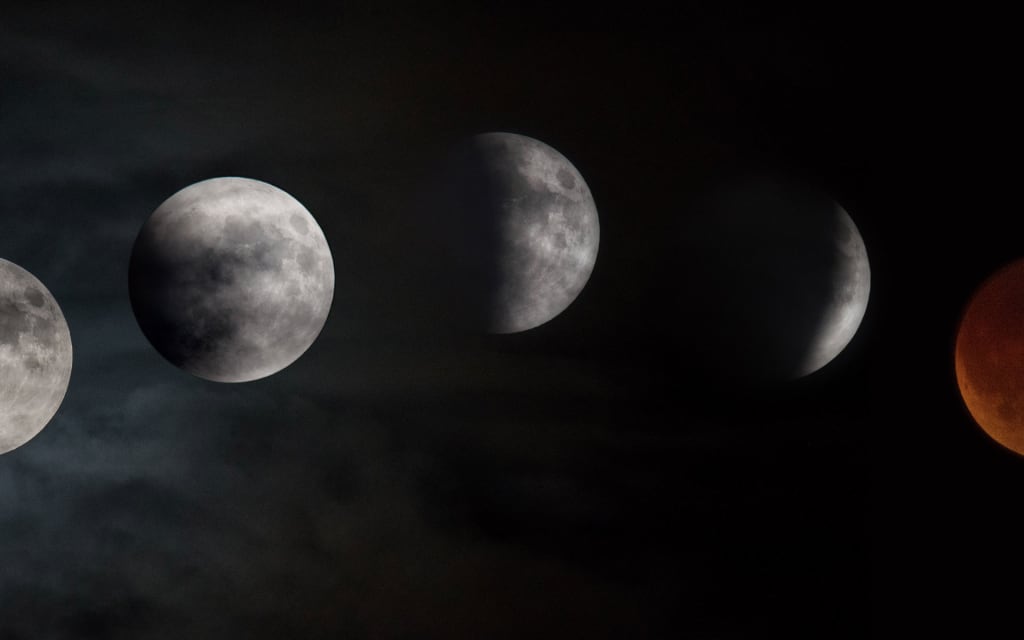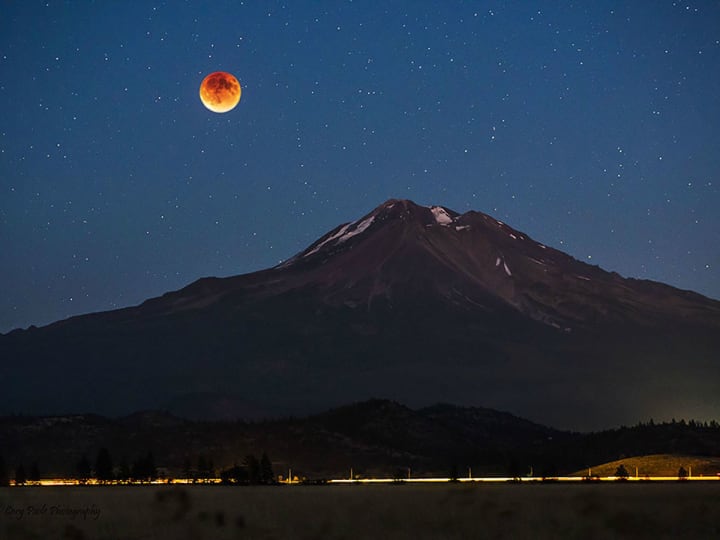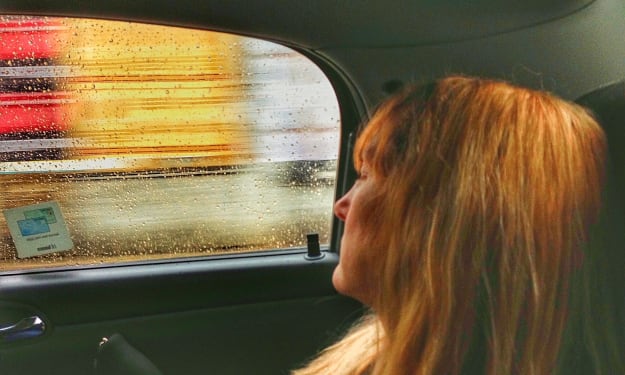Lunar Eclipse Guide
Take a trip to the moon with a lunar eclipse guide.

Only two to four times a year, residents of Earth's western hemisphere will be treated to one of nature's greatest shows. On that night, the full Moon enters Earth's shadow, giving us a total eclipse of the Moon.
An eclipse begins as the eastern edge of the moon glides into the penumbra, the half-shadow cast by the Earth. The beginning of this phase is hardly noticeable, but an hour or two later, you can easily see that the eastern half of the Moon is darker than the western half.
Soon after, the Moon's eastern edge makes first contact with the darker shadow of Earth, the umbra. Then begins the most dramatic part of the eclipse. The Earth blocks most of the Sun's light, but some reddish hues can curve through our atmosphere onto the Moon. The atmosphere blurs the edge between the penumbra and umbra, so again, it isn't possible to see the exact beginning of the umbra's creep across the face of the Moon. For the next hour and five minutes, the dark, coppery coating of light will ooze west. Finally, the whole Moon comes within the umbra, bathed entirely in its eerie glow—totality!
Totality begins about two hours after the beginning of the eclipse and lasts for one hour and 45 minutes. The color of the Moon during totality depends upon the condition of Earth's atmosphere as it bends the light from the Sun onto the Moon. If the atmosphere is clear, the fully eclipsed Moon may be rather bright. Volcanic activity can have a large impact on the brightness of an eclipse. An eruption of Mount St. Helens in 1963 made the total lunar eclipse of 1964 so dark that the Moon was hard to see without a telescope. The darker the eclipse, the easier it will be to see the change of phases from penumbral to umbral and back again.
At the end of an hour and 45 minutes, the Moon begins to pass out of the umbra. The lighter penumbral shades wash the dark, reddish color off the lunar surface, working from east to west. Depending on the positioning of the Moon in relation to the Earth at the time of the eclipse, different time zones will see the ending of the totality first. Others will watch moonset just as the Moon completely leaves the umbra. Only a few time zones will see the entire total phase of the eclipse.
Five hours from the beginning of the eclipse, the Moon will be totally out of the umbra, and only the faint penumbral phase remains. This last phase ends not much later. The eastern edge of the Moon gets lighter and lighter as the penumbra moves west.
An eclipse reminds us that we live in space, on a planet that circles a star. Knowing the way the Sun, Earth, and Moon combine to create eclipses makes these events even more wonderful.
Record the Eclipse
Eclipses of the Moon are great for beginning astronomers, since they don't require caution and special equipment as solar eclipses do. As far as observing goes, all you really need is your eyes. Binoculars are great, too, especially if the eclipse is very dark. High-powered telescopes aren't usually useful, since the main feature of the eclipse, the edge between penumbral and umbral phases, isn't very sharp, and the telescope will only make it muddier.
For recording the eclipse, nothing beats setting up a quality camera to record a time lapse. Photographs just can't catch the slight differences between phases or the subtle colors transmitted to the lunar surface by the Earth's atmosphere.

Photo via coreypoole
Causes of Eclipses
Οne of the first things mapped by the pioneers of astronomy was the path of the Sun on its yearly trip through the sky. They noticed that the Moon's path was almost—but not quite—the same as the Sun's. Sometimes the Moon appeared a little above the Sun's path, sometimes a little below it. Twice a month the Moon crossed the Sun's path. One of the biggest discoveries was that if the Moon was new or full when it crossed the Sun's path, an eclipse would occur. That's why they called the Sun's path the ecliptic.
The ancient astronomers were pretty much stuck with an earthbound point of view. It wasn't until about 300 years ago that Copernicus gave astronomers a good idea of how things looked from space. It became obvious that eclipses are just shadows cast by the Earth and Moon. If the Moon's shadow falls on the Earth, observers see a solar eclipse. If the Earth's shadow falls on the Moon, a lunar eclipse results.

Photo via Sky & Telescope
Conditions for an Eclipse
Conditions have to be just right for an eclipse to occur. First, the Earth, Sun, and Moon must line up in a syzygy (SIZZ-ih-jee). This unusual word stands for a common event: a syzygy happens about twice a month—once when the Moon is new and again when the Moon is full. If we could look at the Earth, Sun, and Moon from far above in space these three bodies would appear to be in line at each syzygy. When the Moon is new, it's between the Earth and the Sun. The Moon's dark side is toward us, and we can't see it against the bright glow of the daytime sky. About two weeks later, when the Moon is full, the Earth is in the middle, and the Moon is reflecting bright sunlight in our nighttime sky.
So why don't we have an eclipse twice a month? The answer lies in the way the Moon orbits the Earth. If we looked at Earth's orbit from the side, we could see that it is basically a flat plane. Astronomers call this the plane of the ecliptic, named after the Sun's apparent path through the sky. Looking from far away, we would see that the Moon's orbit lies at an angle to this plane.
The Moon crosses through the plane of the ecliptic at two points. These points are called nodes. The Moon crosses the ascending node as it goes above the plane, and the descending node as it goes below the plane.

Diagram via Universe Today
Shadows
Now, back to those shadows. The shadow of the Earth, which always points directly away from the Sun, is centered on the plane of the ecliptic, since the Earth is always in this plane. For a lunar eclipse to occur, the Moon must move into the Earth's shadow. This can only happen near a node, where the Moon crosses the plane. And like the Earth's shadow, the Moon must be opposite the Sun—as it is at the full moon syzygy.
The shadow of the Moon also points directly away from the Sun, and it only falls on the ecliptic when the Moon is crossing the ecliptic at a node. If it is between the Earth and Sun (new moon) when this happens, earthbound observers in the shadow will see a solar eclipse.
Both the Earth and Moon cast two types of shadow, a dark, central shadow called the umbra, and a lighter, outer shadow called the penumbra. The Moon casts a small umbra (about 200 kilometers across), and a larger penumbra (about 4000 km across). The Earth casts a large umbra—three times the size of the Moon. The Earth's penumbra is five times the size of the Moon.
Astronomers call the imaginary line connecting the two nodes the line of the nodes. When this line points at the Sun we have an eclipse season. There can be two or three eclipses during an eclipse season. Usually the nodes line up a bit before or after a syzygy. During such a season there will be one solar and one lunar eclipse.
If the nodes aren't perfectly lined up at new moon, the Moon's umbra will miss the Earth, and only the penumbra will strike it. Persons standing in the Moon's penumbra will see a partial eclipse of the Sun.
The Earth's shadow is much bigger, so even if the nodes aren't perfectly lined up during the full moon, the lunar eclipse can be total. A partial eclipse is more likely, however. As you'll see at the beginning and end of this month's eclipse, penumbral eclipses of the Moon are hardly noticeable—the Earth's penumbra is very faint.
If a syzygy occurs at the same time that the nodes line up with the Sun, there will be three eclipses. If the Moon is new, we will have a total eclipse of the Sun somewhere on Earth.
If the nodes line up almost exactly at the same time as the full moon, we'll have a long lunar eclipse. Two weeks before, there will be a partial eclipse of the Sun; Another partial eclipse of the Sun will follow two weeks after, when the Moon is new again.
Eclipse seasons occur a little less than six months apart. If the first season of a year occurs early enough, three eclipse seasons can be squeezed into one year. The Moon reaches full only about a minute after it crosses the node, so the Moon takes the longest possible path through the Earth's umbra. The result is the longest totality possible—one and three-quarters hours. The two solar eclipses on each side of the lunar eclipse are very partial.
Recommended Reading
Observing a solar eclipse is just as intriguing as a lunar eclipse, but the process requires far more caution. Learn more about observing lunar eclipses and everything you need to know about observing solar eclipses in Eclipse!: The What, Where, When, Why, and How Guide to Watching Solar and Lunar Eclipses.
Eclipse! provides you with the information you need to observe eclipses, take photos, and keep detailed records of the experience. The volume includes explanations of why eclipses happen, how to view and photograph them, and a calendar of when and where they will occur.
About the Creator
Futurism Staff
A team of space cadets making the most out of their time trapped on Earth. Help.






Comments
There are no comments for this story
Be the first to respond and start the conversation.